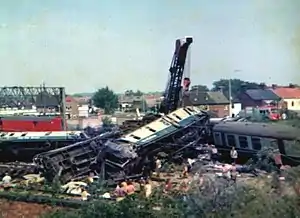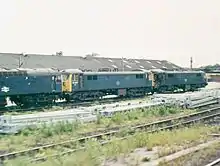Nuneaton rail crash
The Nuneaton rail crash occurred on 6 June 1975, on the West Coast Main Line just south of Nuneaton railway station in Warwickshire, England.
| Nuneaton rail crash | |
|---|---|
 The aftermath of the crash, which killed six people and injured 38. | |
| Details | |
| Date | 6 June 1975 |
| Location | Nuneaton, Warwickshire |
| Country | England |
| Line | West Coast Main Line |
| Operator | British Rail |
| Cause | Overspeed on temporary track Driver error/lineside equipment failure |
| Statistics | |
| Trains | 1 |
| Deaths | 6 |
| Injured | 38 |
| List of UK rail accidents by year | |
The train crash happened when the 23:30 sleeper from London Euston to Glasgow derailed after entering a temporary speed restriction at too high a speed. Six people (four passengers and two staff) died and 38 were injured. In the subsequent inquiry,[1] the accident was deemed to have been caused by driver error, partially due to the failure of lineside equipment warning of the speed restriction.
The accident
The accident occurred at approximately 01:54, as the train approached Nuneaton station. The train was running over an hour late because of a locomotive failure further south. The train was composed of two Class 86 electric locomotives (nos. 86006 and 86242; both later repaired) and 15 carriages, including 12 Mark 1 sleeping cars, two Brake Gangwayed and a Restaurant miniature buffet.[1]
Just south of Nuneaton station, a temporary speed restriction of 20 mph (32 km/h) was in place for a distance of just over a mile because of a track remodelling scheme. The warning board[2] was placed at the standard 'service braking distance' of a mile and a quarter before the restriction. This board should have been illuminated, but was not. The driver claimed that he assumed it meant the restriction had been lifted and did not need to slow the train. It was not until he saw the correctly illuminated 'commencement board' at the start of the restriction that he realized it was still in place, but by then it was too late.[1]
Despite an emergency brake application, the train entered the 20 mph restriction at an estimated 80 mph (130 km/h) and derailed on a sharply curved length of temporary track being used during the remodelling scheme. The locomotives became detached from one another; the first continued in a straight line and came to a stop half way through the station between the platforms, and the second veered sideways, striking and then mounting the northbound platform, coming to a rest after colliding with the platform canopy. The coaches behind them derailed and zig-zagged across the tracks causing severe damage to the track and lineside structures. The first two coaches stayed mainly upright, but the next four fell on their sides, badly crushing the third, fourth and fifth coaches. All the fatalities and most of the injuries occurred in these four sleeping cars. Every vehicle on the train was derailed except the last. The inquiry noted that casualties would have been much higher if not for the lightly loaded nature of the train (there were fewer than 100 passengers on board).[1]
Over 455 yards (416 metres) of track was destroyed along with three lineside electrification gantries, as well as severe damage to an overhead road bridge, numerous items of trackside equipment, and the locomotive of a passing freight train (Class 25 number 25286), which was damaged by falling overhead line equipment.[1]
On board the train was the Minister for Agriculture, Fred Peart, who survived the accident with minor injuries.[3]
 Clear up work following the crash.
Clear up work following the crash..jpg.webp) View of crash site during the clear up, showing the extent of damage to the surrounding infrastructure.
View of crash site during the clear up, showing the extent of damage to the surrounding infrastructure..jpg.webp) The heavily damaged 86242, after the accident.
The heavily damaged 86242, after the accident. The 3 locomotives damaged in the crash are seen a few days later at Crewe Electric TMD.
The 3 locomotives damaged in the crash are seen a few days later at Crewe Electric TMD.
The Inquiry

The inquiry, conducted by Major C.F. Rose, found the accident to be due to the following causes:[1]
- The advance warning board was not illuminated because the gas lighting equipment had been set up incorrectly, and had gone out some time between 01:10 and 01:40. The lights had gone out because the gas cylinder supplying it had run empty; the equipment had two gas cylinders, and included a valve which would allow the gas supply to automatically switch from one cylinder to the other when one was empty, but this valve was not being used.
- A number of drivers on preceding trains noticed that the lights had gone out, but did not stop and report it as they should have done according to the rules.
- Although he claimed otherwise, it was thought likely that the driver, in his haste to make up lost time, forgot about the speed restriction without the reminder of the warning board.
The driver, Mr. J. McKay, was later charged with manslaughter but found not guilty after a trial the following year.[1]
A number of recommendations to prevent a recurrence of the accident were accepted by the British Railways Board, the main one being the installation of temporary Automatic Warning System magnets at speed restriction locations to ensure that drivers were given audible notice of speed restrictions.[1]
Memorial
A plaque commemorating the victims of the crash, as well as the actions of emergency services personnel, was unveiled at Nuneaton station in August 2015.[4]
References
- Accident Report Retrieved on 2007-05-01
- "Nuneaton accident report. Paragraph 8. "At a distance in advance of the commencement of the restriction that is specified in the Rule Book, a WARNING BOARD is erected at the lineside" (pdf). Dot. Retrieved 25 December 2018.
- "Nuneaton train crash: Vivid memories 40 years on". Coventry Telegraph. Retrieved 23 October 2016.
- "Nuneaton Memorial unveiled 40 years on from Nuneaton train disaster". Coventry Telegraph. Retrieved 23 October 2016.
External links
| Wikimedia Commons has media related to Nuneaton rail crash. |